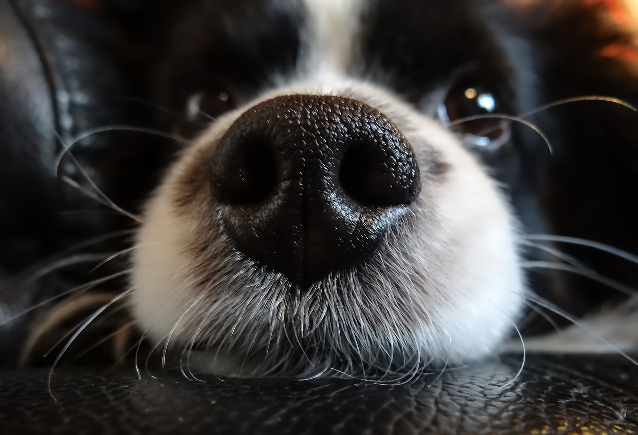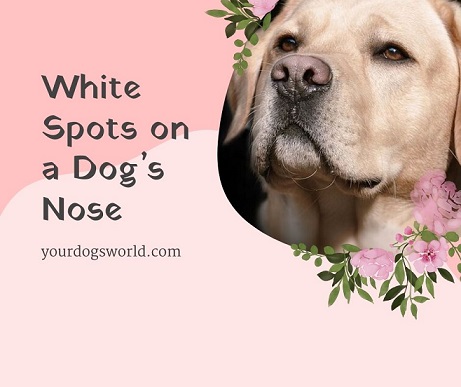All dogs are born with healthy noses that bear a natural color. A dog’s nose can be black, brown, or pink. So when you see white spots on a dog’s nose, any dog owner would look concerned!
Seeming odd and scary it is a worry! But, white spots on a dog’s nose is not always a danger.
White spots on a dog’s nose are often caused by pimples, vitiligo, wear and tear, autoimmune disease, or simply aging. Treatment for white spots on your dog’s nose ranges from moisturizer to antibiotic treatment, or even surgery!
What do White Spots Look Like on a Dog’s Nose
White spots on a dog’s nose might appear like a minute discolored or white dot. Depending on the reason, it could appear as one spot or many small spots. So, as time passes these spots might grow, but not all white spots will grow.
The size and speed by which white spots appear on a dog’s nose can dictate its severity. If the white spots are large and grow very rapidly, a vet’s advice is important.
Even if it is slow-growing, visit a vet as a precaution. It will also help you feel less worried!

What can cause White Spots on a Dog’s Nose?
White spots might appear on a dog’s nose for a number of reasons. When you first notice them on your dog’s nose, do not panic and jump to conclusions. Here are various causes of a white spot on your dog’s nose.
Vitiligo
The skin on the nose contains cells called melanocytes. The sole purpose of these cells is to create a substance called ‘melanin’. Melanin is responsible for giving a dog’s nose its color.
Vitiligo is a medical condition in which melanocytes are killed or lose their ability to produce melanin.
Types of Vitiligo
Depending on the area affected, vitiligo is of two types:
- Focal Vitiligo
This type of vitiligo affects one area of the dog. If it occurs on a dog’s nose, it is called “Snow Nose”.
- Generalized Vitiligo
Generalized vitiligo occurs on various parts of the body. The nose, hair, and skin are all affected by patches of white fur and skin.
The dog’s nose turns white from its original color. Once turned white, the nose of your dog may never return to its original pigment!
Some dog breeds are more at risk of Vitiligo than others, these include:
- Daschund
- Doberman Pinscher
- German Shepherd
- Golden Retriever
- Irish Setter
- Old English Sheepdog
- Rottweiler
- Siberian Husky
- Labrador Retriever
Because of obvious reasons, vitiligo is easier to spot in dogs with darker coat colors.
Kennel Nose
Do you practice putting your dog in a crate or kennel often? This could be a cause for “kennel nose”. Your dog could be trying to escape the crate, dig inside the crate, or could just be anxious.
All of which lead to the creation of white raw spots on their noses.
Pimples
Like humans, dogs are also capable of getting pimples. Pimples are a natural condition occurring when pores in a dog’s nose become clogged. Dirt, soil debris, and oil are the main reasons the pores become blocked.
Keeping your dog’s nose clean can minimize pimples. This is important seeing as the sense of smell is a dog’s most prized skill.
Nasal hyperkeratosis
Keratin build-up leads to nasal hyperkeratosis.
It forms a dry, hard, cracking of the nose. In severe cases, a white bump can form that protrudes from the nose. Severe cases will require the outgrowth to be cut away.
Mild cases are handled by moisturizers that soften and hydrate the nose. Inflammation can be treated using antibiotics and low concentration steroids.
Pemphigus Foliaceus (PF)
Pemphigus Foliaceus is an autoimmune disease common among middle-aged dogs of any breed.
This condition is characterized by the presence of pustules and scabs anywhere on the face of a dog (nose, ears, head).
More common in Chow Chows and Akitas, PF is known to be initiated by genetic hereditary, high Ultraviolet (UV) light exposure, and viral infections. Luckily, dogs with this disease respond well to topical steroids and corticosteroids.
Interested in adopting an Akita, but want to know “Do Akitas Like to Cuddle”?
How to Treat White Spots on a Dog’s Nose
A tiny white spot on your dog’s nose is probably not life-threatening. But, if the white spots continue to grow rapidly, it requires a second look. At this point, it is wise to have your vet take a look.
Depending on what the vet thinks, he might require further testing. Tissue scraping, blood work, and a biopsy might be necessary to correctly diagnose the issue.
This is important since assuming the wrong diagnosis will lead to wrong treatment. In turn, it will be tough to solve the issue.
Depending on the causes, these spots on dog noses can undergo treatment using a range of medicines.
Moisturizing creams, antibiotics, and steroids are sufficient in mild cases. Severe cases may require a surgical procedure if they have formed pimples or outgrowths.
My Dog Has a White Bump on His Nose, Is It Cancer?
Depending on the bump size, shape, color, and rate of growth, it could be malignant or cancerous.
There are various causes of a lump or bump on a dog’s nose. And, in almost all occurrences of these bumps, there is a need for further investigation.
A tissue biopsy can provide clarity to the severity of the bumps. Biopsies will confirm or refute a cancer diagnosis.
Sometimes puncturing the bumps also helps to diagnose the issue correctly by observing what is inside the bump. Consequently, a thick white substance oozes out from pimples.
Is your dog ill and pooping white specks? Find out what White Specks in Dog Poop means.

